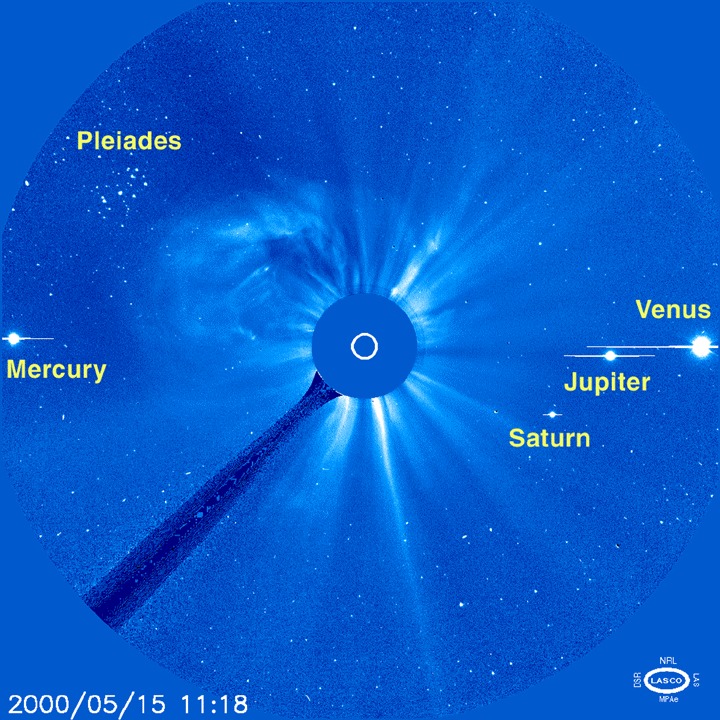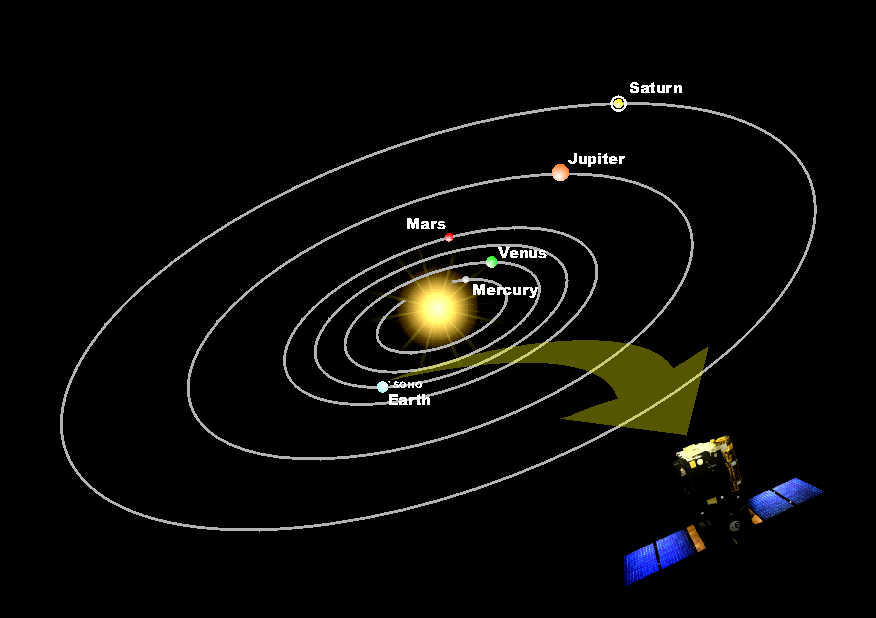
Image 1 Caption: A SOHO (1995--2025?) LASCO image of the Sun's corona with the solar photosphere masked. This is image is from 2000 May03.
Features:
- The Sun is covered by a mask which is
held by an arm which appears as dark band.
The circle on the mask is the size of the
solar photosphere,
yours truly guesses.
- The corona is the whispy white
haze extending from the Sun.
It is very hot: ∼ 10**6 K, but very low density and so does NOT
radiate strongly.
The whispy appearance is because the particles (principally completely ionized hydrogen (H) helium (He), and electrons) are charged particles and helix along magnetic field lines emanating from the Sun.
- Every image of the corona
looks different for two reasons.
First, camera sensitivity.
The higher the sensitivity, the more
corona
you see.
The corona has NO sharp
outer surface: it just morphs into the
solar wind as you go outward from
the Sun.
In fact, the corona can
be traced out to ∼ 30 R_☉ (∼ 0.14 AU)
(Se-151) which is
still well within Mercury's
mean mean orbital radius
0.387098 AU.
Second, the corona is affected by Sun weather which is largely magnetic. As the Sun's magnetic field varies in time, so does the corona.
- The luminosity and white
color of the
corona is principally due to
scattering of sunlight
off free electrons
and to a much lesser extent
free protons via
Thomson scattering
(see Wikipedia: Stellar corona).
Free Electrons and free protons are, in fact, shiny and scatter light electromagnetic radiation (EMR) in a frequency independently. When they are bound into atoms or, in the case of electrons, other structures, their interaction with EMR is much complex and includes absorption as well as scattering.
- The image is partially false color
since space is NOT
blue.
The corona is
white as aforesaid.
However, yours truly does NOT know exactly what
wavelength band
the image is taken in.
Probably a broad band in the somewhere in the
visible band (fiducial range 0.4--0.7 μm
= 4000--7000 Å).
- This 2000
May03 image
also shows 4
planets
(Mercury,
Venus,
Jupiter,
and Saturn)
and the
Pleiades
(an asterism
in the northwest
of constellation
Taurus).
- The planets are
resolved.
One is seeing their diffraction patterns.
Note Venus looks almost as large
as the solar photosphere.
The "lines" through the planets are an artifact of overexposure. They may be diffraction patterns of some kind. The diffraction patterns would have to be caused by some object perpendicular or parallel to the "lines" in order to give the "lines" the symmetry they have. So evidently the "lines" are NOT due to the mask arm.
- Image 2 Caption: A cartoon of the orbits of the planets and of the Solar and Heliospheric Observatory (SOHO, (1995--2025?)) SOHO (1995--2025?) is located nearly at the Earth's Lagrange point L1, and so is permanently nearly between the Earth and the Sun on the Earth-Sun line. This peculiar orbit is described at Wikipedia: SOHO (1995--2025?): Orbit.
- See the Solar corona videos below:
- EOF
-
Credit/Permission: NASA/SOHO (1995--2025?),
2000 /
Public domain.
Download site: NASA/SOHO: Four Planets and the Pleiades!.
Local file: local link: solar_corona_soho.html.
File: Sun file: solar_corona_soho.html.
- Image 2 Caption: A cartoon of the orbits of the planets and of the Solar and Heliospheric Observatory (SOHO, (1995--2025?)) SOHO (1995--2025?) is located nearly at the Earth's Lagrange point L1, and so is permanently nearly between the Earth and the Sun on the Earth-Sun line. This peculiar orbit is described at Wikipedia: SOHO (1995--2025?): Orbit.
